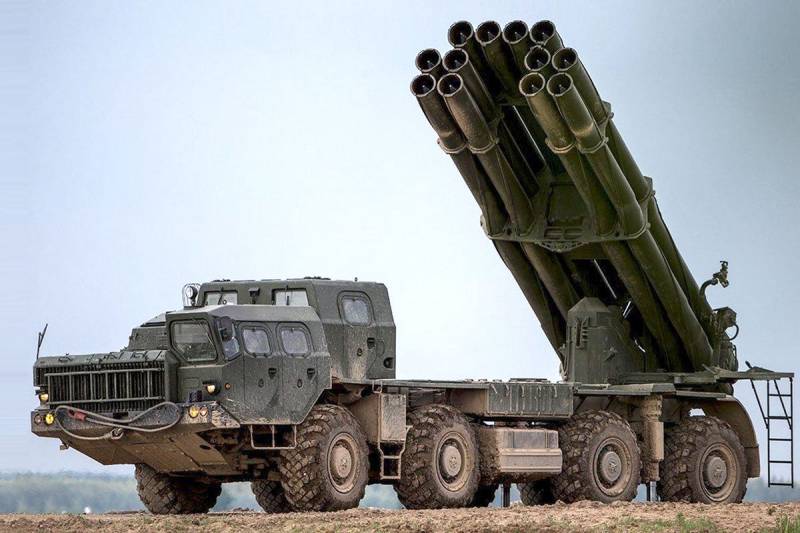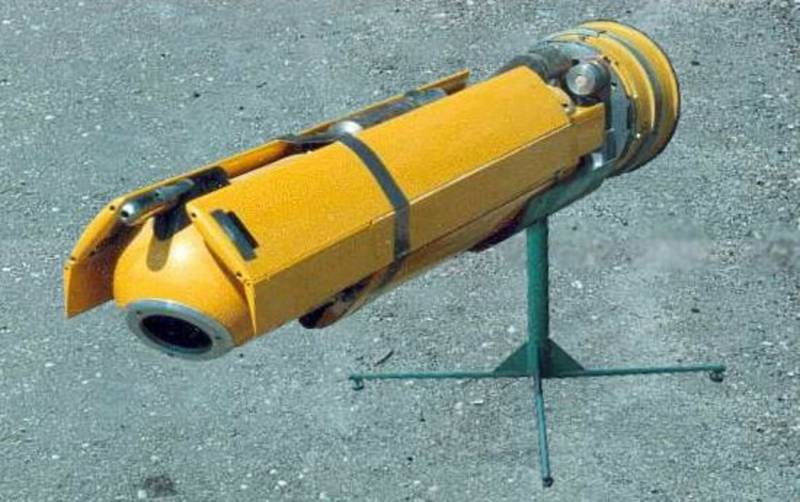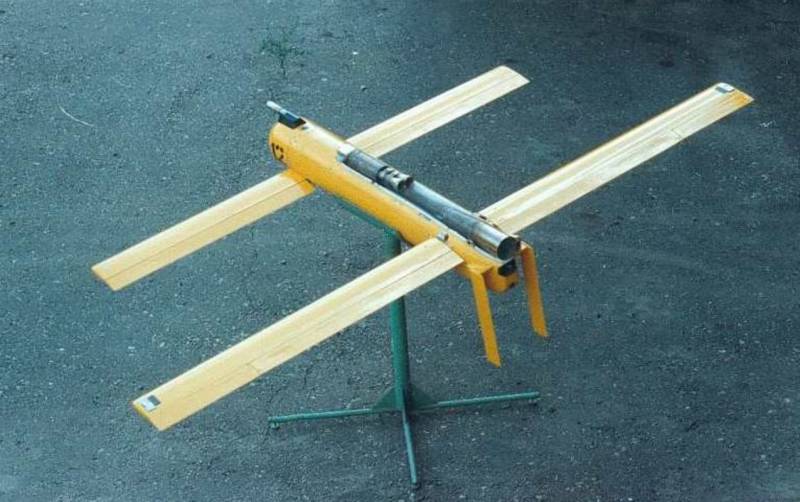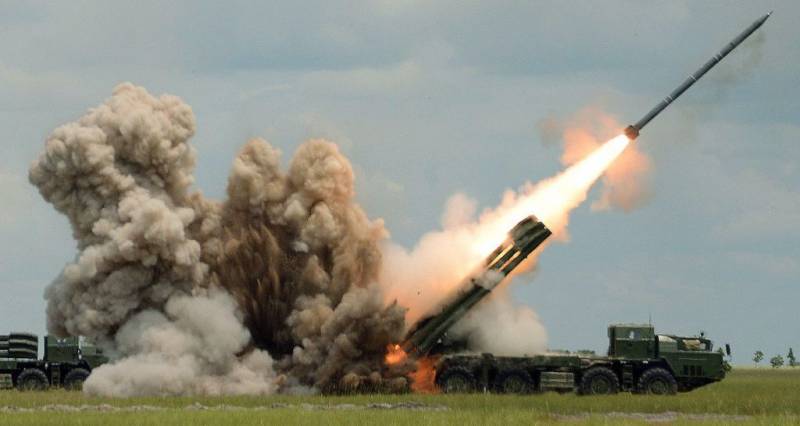"Tornado-S" will receive a new projectile from the UAV
The Tornado-S multiple launch rocket system can use a wide range of 300-mm rockets with different flight characteristics and different combat equipment. In particular, missiles with a load in the form of unmanned aerial vehicles for various purposes are being developed. Recently it became known that such a UAV can carry electronic warfare equipment.
Perspective development
In mid-April, the head of the electronic warfare troops of the Russian army, Lieutenant-General Yuri Lastochkin, spoke about plans to create new systems and complexes. Among other things, he mentioned new electronic warfare systems based on MLRS and UAVs. However, no details were given.
New information on this subject was published by Izvestia on September 2. From its sources in the military department, the publication learned that development work is currently underway to create a new electronic warfare complex. Some information about its functions and capabilities is given, but the technical details are not specified.
The new project provides for the creation of a light UAV with electronic warfare devices on board. Limited dimensions will allow it to be placed in the head of a 300-mm rocket for the Tornado-S MLRS. With the help of a rocket, such a drone will be delivered to a given area at a distance of tens of kilometers. There he will barrage for some time and perform his tasks. Return is not provided.
It is reported that the equipment on board the UAV will be able to detect and suppress radio communication channels, radar signals, etc. At the same time, the exact characteristics of such an electronic warfare system are not reported.
The electronic warfare complex based on MLRS and UAVs can be used in offensive and defensive operations. Its presence will significantly expand the capabilities of rocket artillery and ground forces in general. At the same time, the air platform used will provide the necessary flight and technical characteristics, as well as reduce the cost of combat work. Besides, Drones take over the work of jamming aircraft or helicopters - and they will not be at risk.
It is not known how far the work has progressed. The timing of the completion of the project and the subsequent adoption of the complex into service is also unknown. Probably, news this kind will appear later, when the project reaches testing, and its future becomes clear.
Finished sample
It should be noted that the current project of a special missile for "Tornado-S" is not the first of its kind. Experiments with the placement of UAVs in a 300-mm rocket began back in the nineties. In the future, the development of unmanned vehicles made it possible to create a modern project with high performance.
At the end of the 90s, Enix introduced the T300 UAV, designed for use in 9-mm rockets. In turn, NPO Splav, which is developing domestic MLRS, has developed a 534MXNUMX missile for such a UAV. To simplify future production, such a projectile was unified as much as possible with the other range of ammunition for the Smerch MLRS.
The T90 is an aircraft-type UAV with a specific design. It was built in a cylindrical fuselage and equipped with two pairs of planes. When inside the rocket, the planes are folded along the fuselage; when reset, they open up, and the UAV starts flying. Two keels of the lower location are made in a similar way.
The drone received a pulsating air-jet engine. A video camera with equipment for signal transmission to the operator's console was placed in the bow. A remote control system with some degree of autonomy was used. Communication range - 70 km.
The length of the T90 product slightly exceeds 1,5 m, the fuselage diameter is 200 mm. The span of the front wing is 1,915 m, the rear wing is 2,52 m. The starting weight is 40 kg. With the help of a PuVRD, the drone can reach speeds of up to 150 km/h. The duration of the flight is up to half an hour. On tests, the UAV was equipped with a landing parachute, but in a combat situation, the return of the product is not provided.
In 2017, NPO Splav reported that the projectile from the UAV was already ready and was waiting for the customer. Last fall, it became known about the assembly of an experimental batch of such products. In the near future it was planned to use it in preliminary tests. Such events and their results have not yet been reported, but the planned tests should not take long. Based on their results, the Ministry of Defense may adopt a new projectile into service.
Development potential
Thus, the domestic defense industry proposed and implemented an original idea in the field of ammunition for MLRS quite a long time ago, and now it is engaged in its further development. A 300-mm projectile with a reconnaissance UAV has been developed and successfully brought to testing, and work is underway on an ammunition carrier for an EW-equipped drone.
It can be expected that this direction will be further developed, and in the foreseeable future, new ammunition for the Smerch / Tornado-S from other types of UAVs will appear. Future drones will be able to expand the range of tasks to be solved or become a replacement for existing products. In general, the prospects for the direction depend only on the wishes of the customer, while the industry has already proven its ability to create such projects.
If the existing models pass the tests and are put into service, the whole direction will be further developed. It is possible to develop shells from UAVs for other purposes. In addition, there is a need to create a modern analogue of the T90 product with higher performance and on the current component base.
A rather successful platform in the form of an existing 300 mm caliber rocket contributes to the further development of the direction. It has a payload compartment with a length of more than 1,5 m and a diameter of 280-290 mm. The carrying capacity of the ammunition exceeds 250 kg. The firing range, depending on the modification, can exceed 70 km.
As recent projects show, modern technologies and the element base make it possible to create a compact UAV that fits into a rocket and shows high performance. Due to a special launch method, it is possible to increase the radius of operation of the complex as a whole and drastically reduce the flight time to a given area.
The use of drones with different functions can improve the capabilities of the MLRS. So, a UAV with optical equipment can be used for additional reconnaissance of a target before firing and subsequent adjustment of fire. Loitering ammunition can be created in addition to other missiles and drones. In this case, all the advantages of this class will be combined with the characteristic features of 300-mm shells.
Of great interest is the idea of a drone with an electronic warfare system. Such a product will be able to detect sources of radio signals and issue target designation to the MLRS. In addition, with the help of interference, he will have to suppress counter-battery radars and reduce the likelihood of a retaliatory strike.
It should be noted that "Tornado-S" will be able to use shells from the UAV along with regular ammunition. This means that one combat vehicle will solve several different tasks at once, and its fire and combat capabilities will improve. You will have to pay for this with some reduction in the impact part of the ammunition, but the UAV shells fully compensate for these losses.
New Components
The development of domestic multiple launch rocket systems continues. To improve the efficiency of combat vehicles, new means of fire control, navigation and communications are used. Improved rockets are being developed. In addition, it is proposed to introduce new components for this area, such as UAVs for various purposes.
The first projectile of a new type with an unusual load has already been tested and may enter service in the foreseeable future. A new ammunition of this kind with electronic warfare functions is also being developed. The latest news shows that the army is showing interest in these developments. They get a chance to enter service, as a result of which rocket artillery will be able to further improve their capabilities.





Information